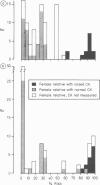Abstract
With the aim of offering carrier detection, genetic counselling, and prenatal diagnosis to as many families with Duchenne (DMD) and Becker (BMD) muscular dystrophy as possible, we used available DNA probes to determine the usefulness of the RFLP approach. We report in detail the risks calculated using Bayesian theory and combining pedigree and creatine kinase (CK) data with information derived from the RFLP studies. To date we have analysed members of 28 DMD families (10 familial, 18 sporadic) and six BMD families (four familial, two sporadic) with the closely linked pERT probes 87-1, 87-8, and 87-15 (DXS164). In addition, key members of all families were analysed with probes D2 (DXS43), C7 (DXS28), 754 (DXS84), and L1 X 28 (DXS7). Of the 97 females at risk of being carriers (not including 26 obligate carriers), the RFLP results were compatible with carriership in 22 and not in 51. In 24 females (including 17 mothers of sporadic cases), no information regarding carriership was derived from the RFLP studies. There was no disagreement between pedigree information, clearly raised CK values, and DNA studies. Of 52 obligate or possible carriers under the age of 45, prenatal diagnosis is possible in 49. Prenatal diagnostic RFLP studies have so far been done in three women. In one sporadic DMD family and one BMD family with three affected males the probands showed a deletion involving the three pERT87 subclones used. Experience derived from these families indicates that in our society genetic counselling in X linked muscular dystrophy is received with approval or even enthusiasm in spite of the 5% error estimate that we have quoted for pERT87 derived results.
Full text
PDF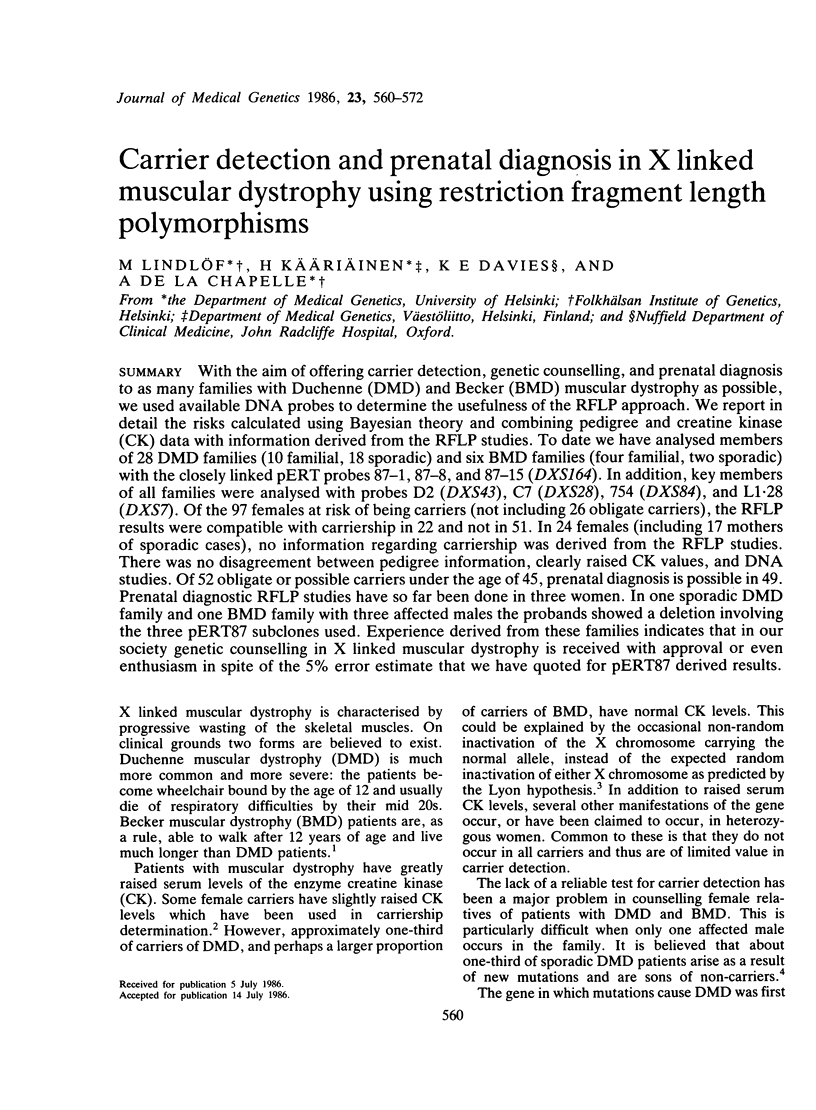
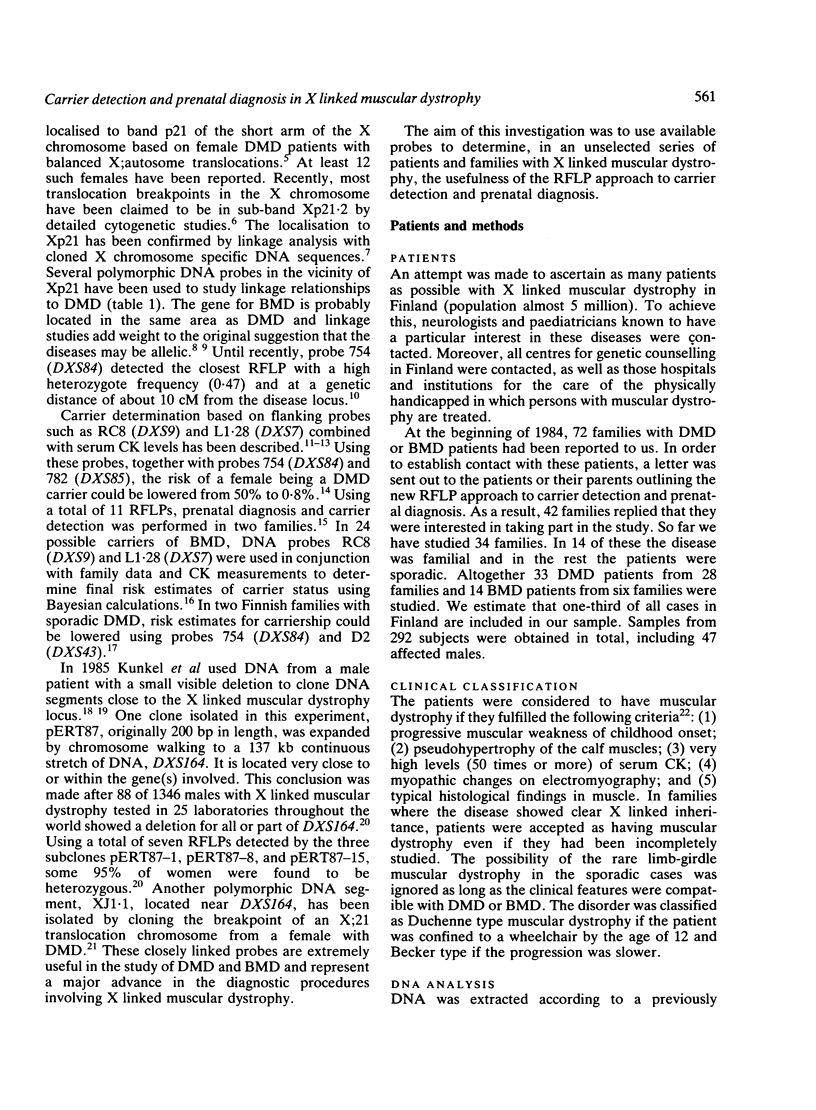
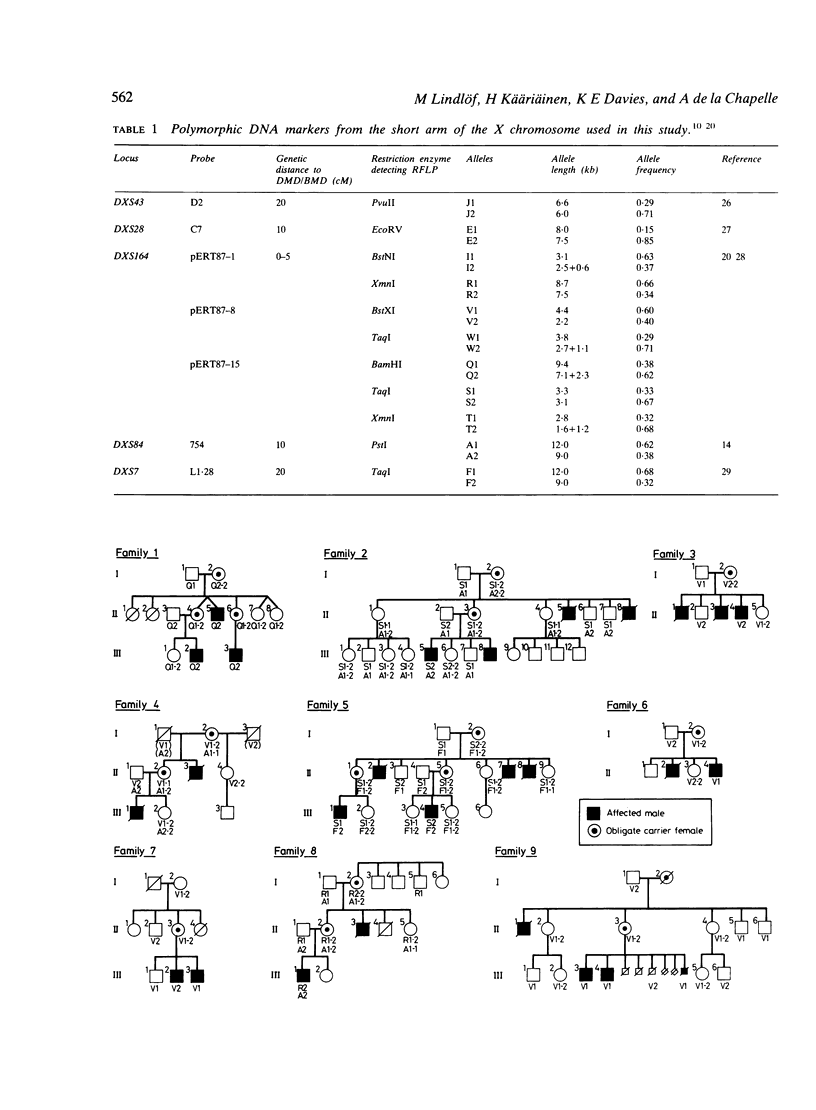
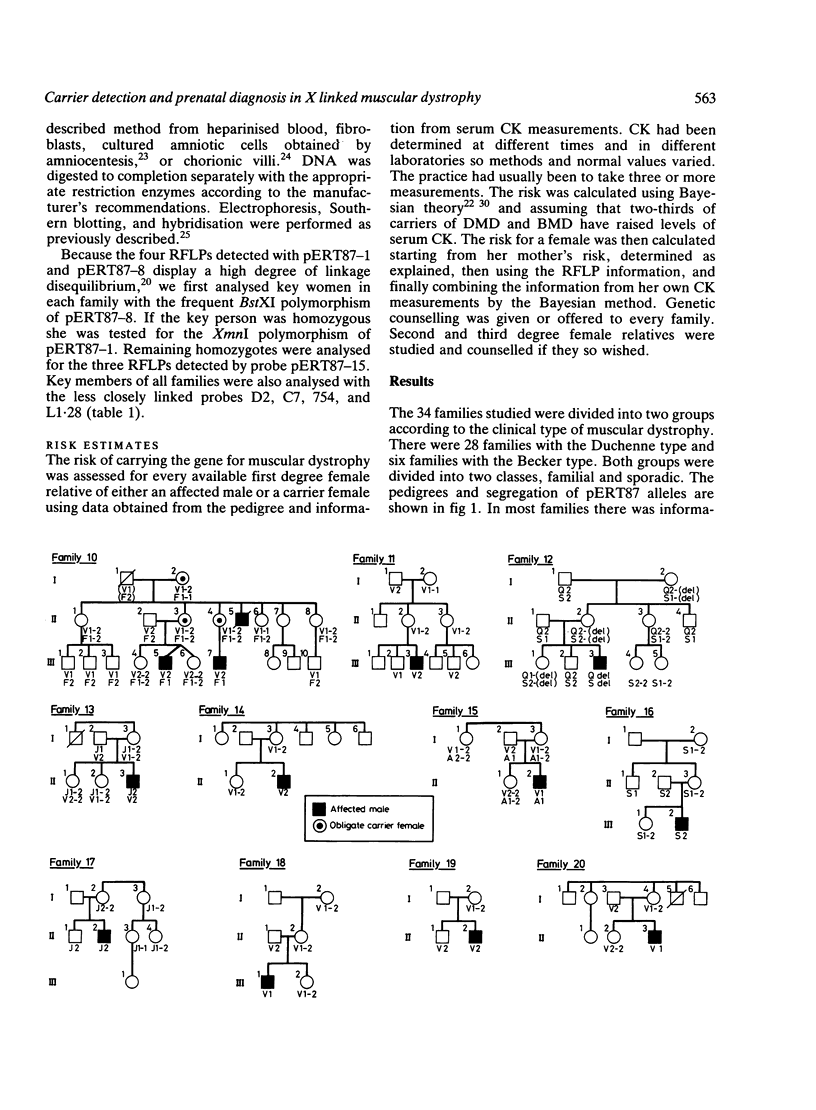
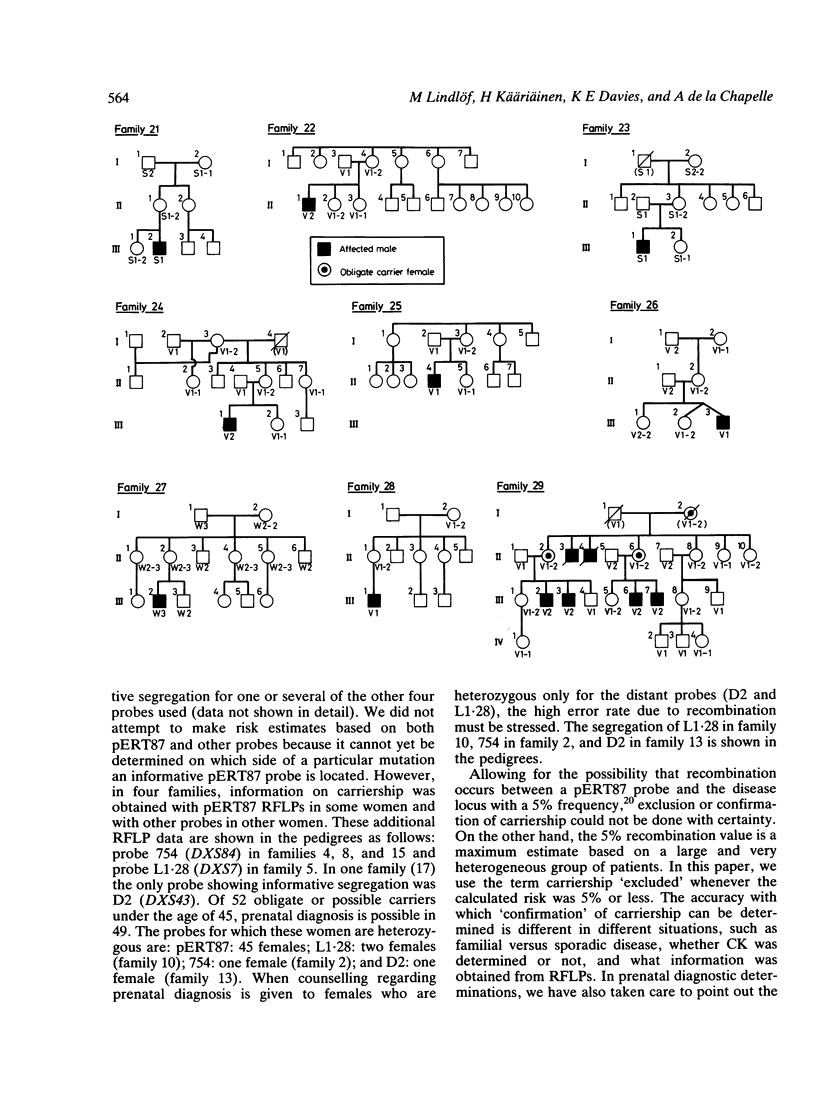
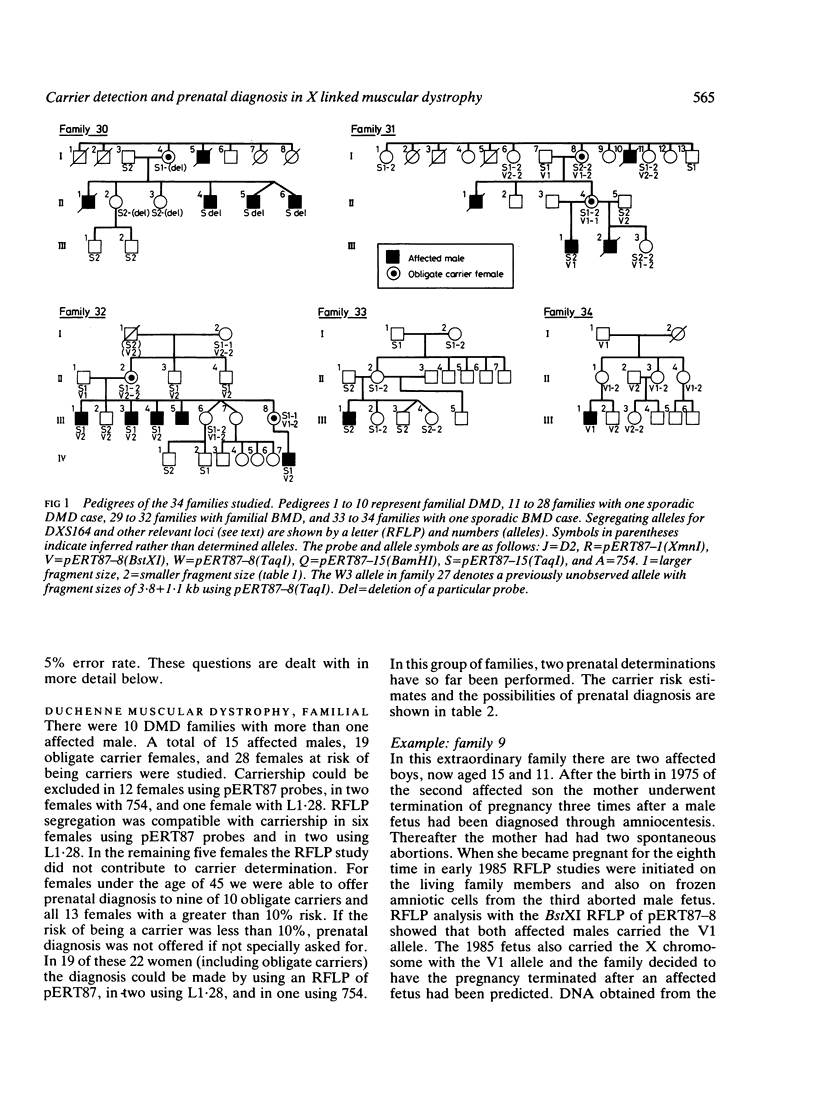
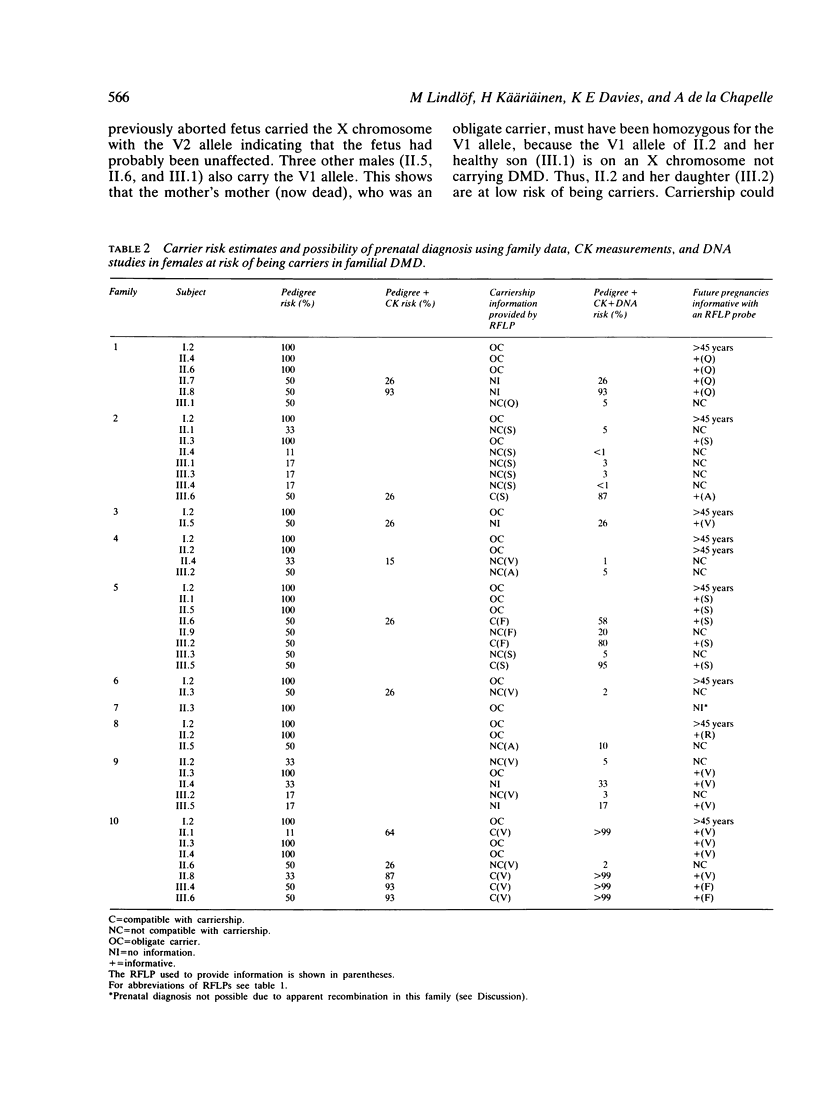
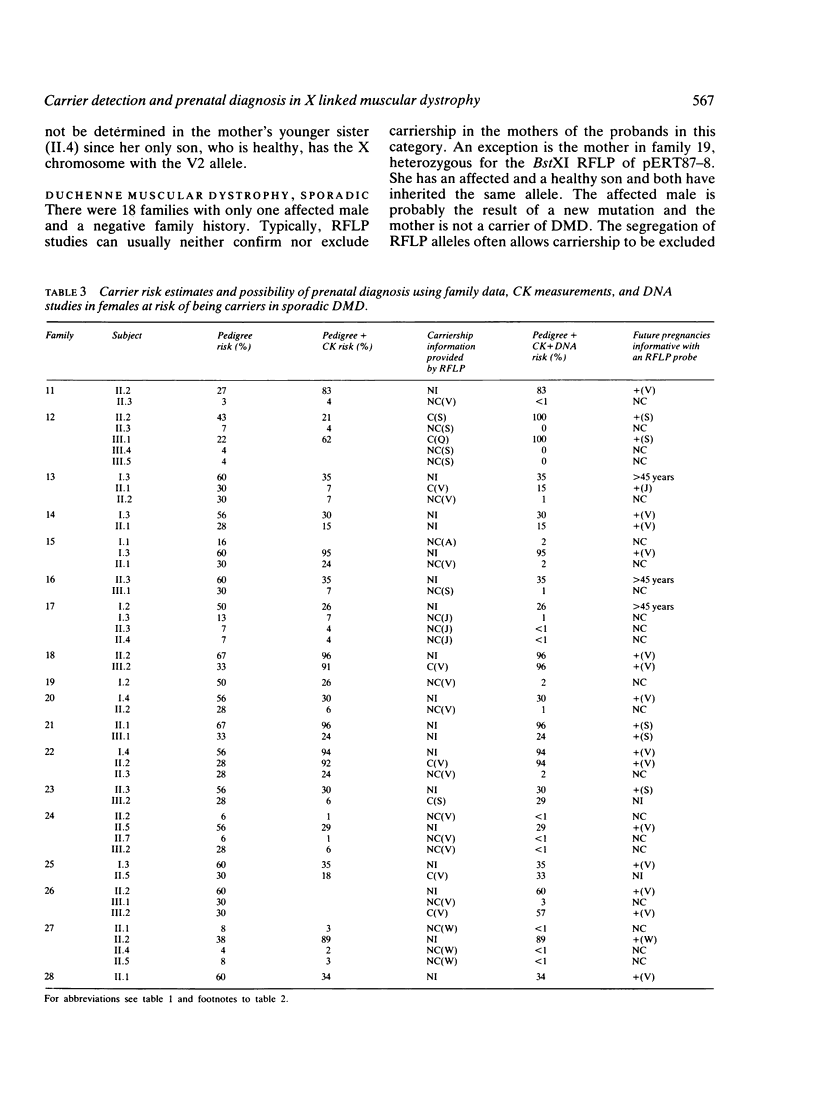
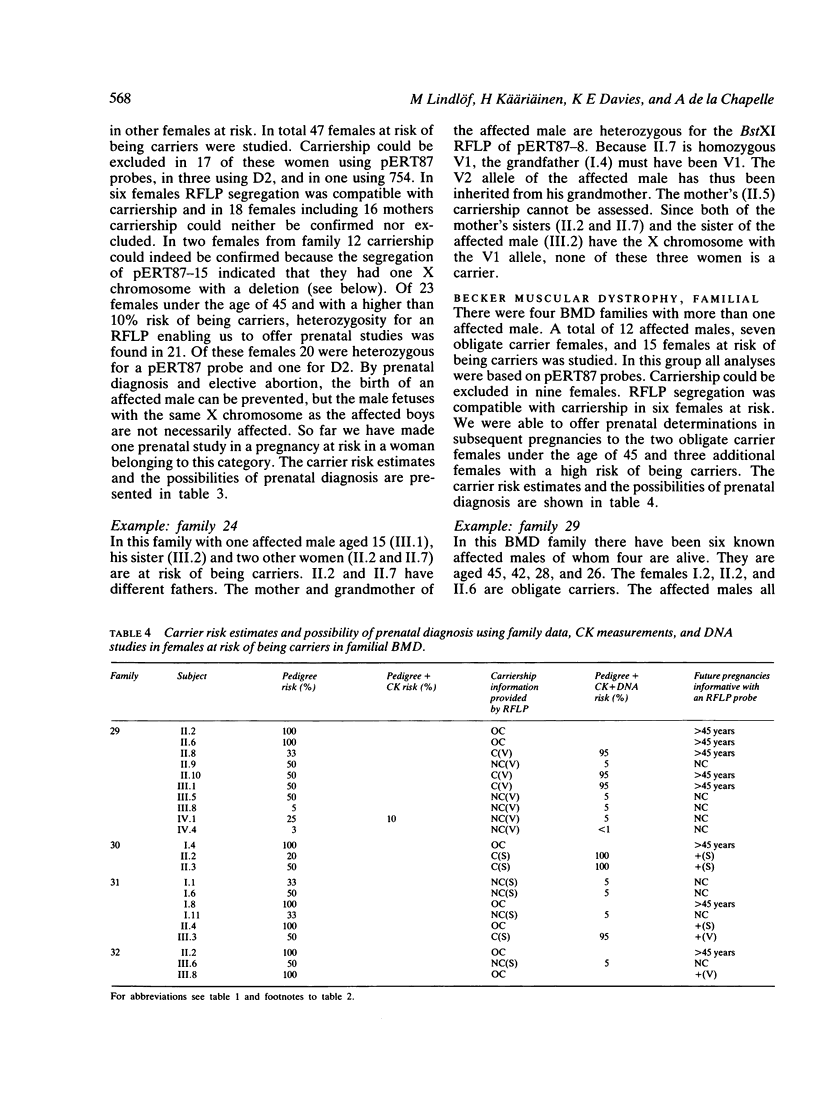
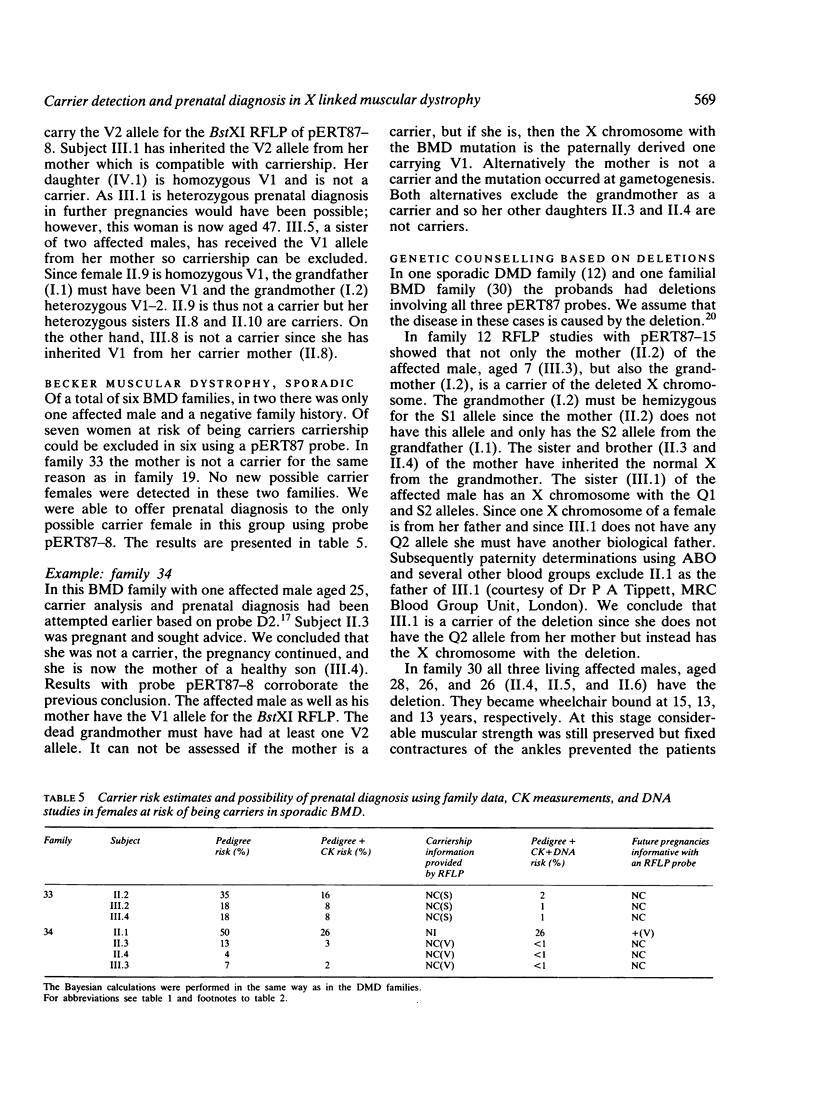
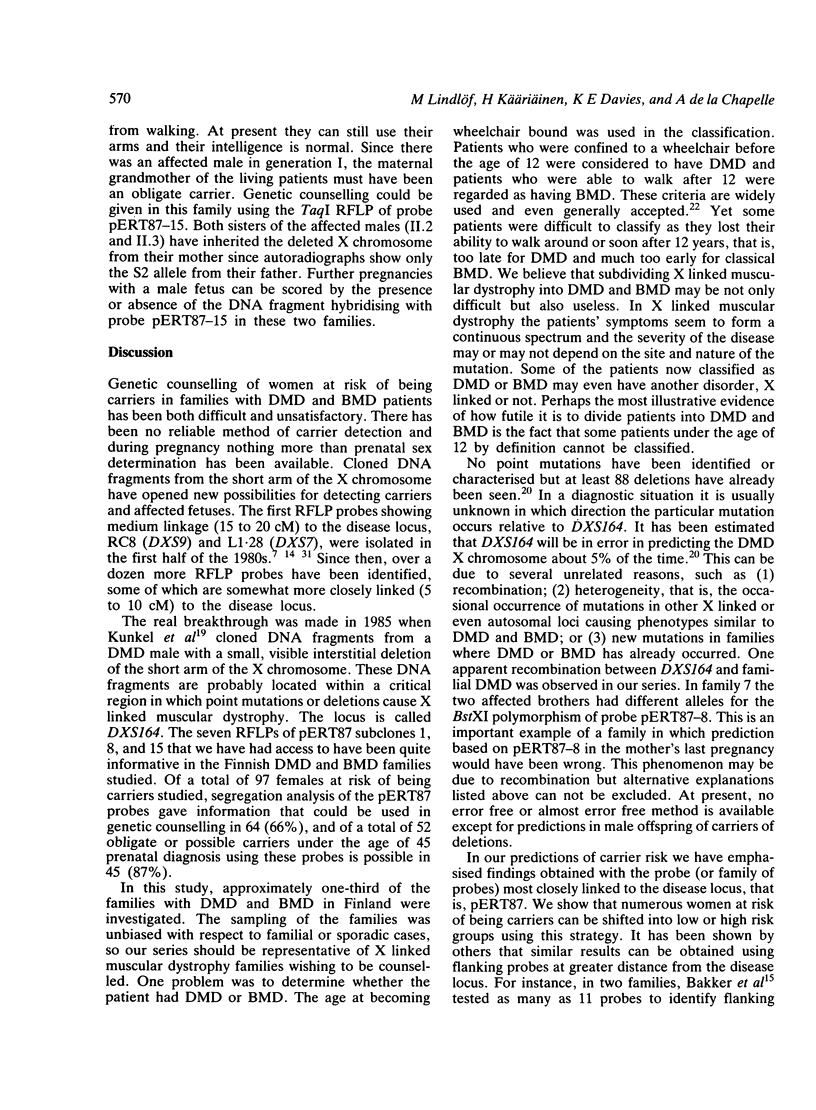
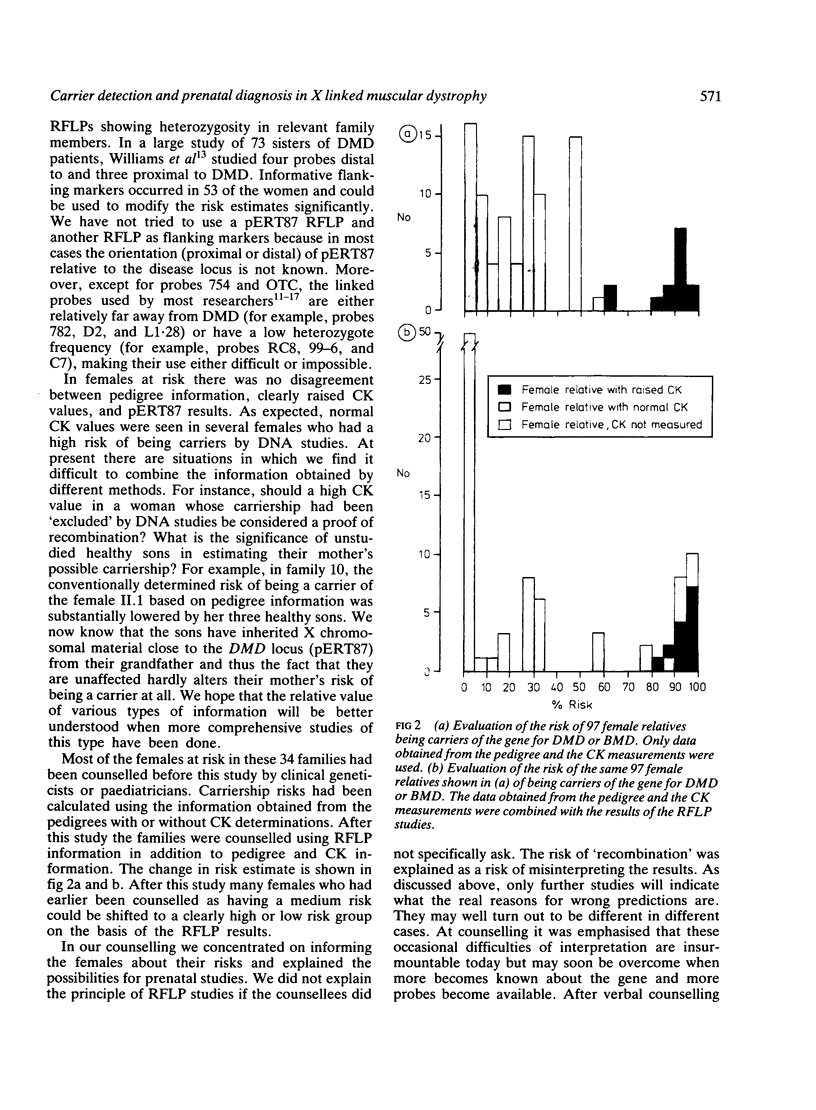
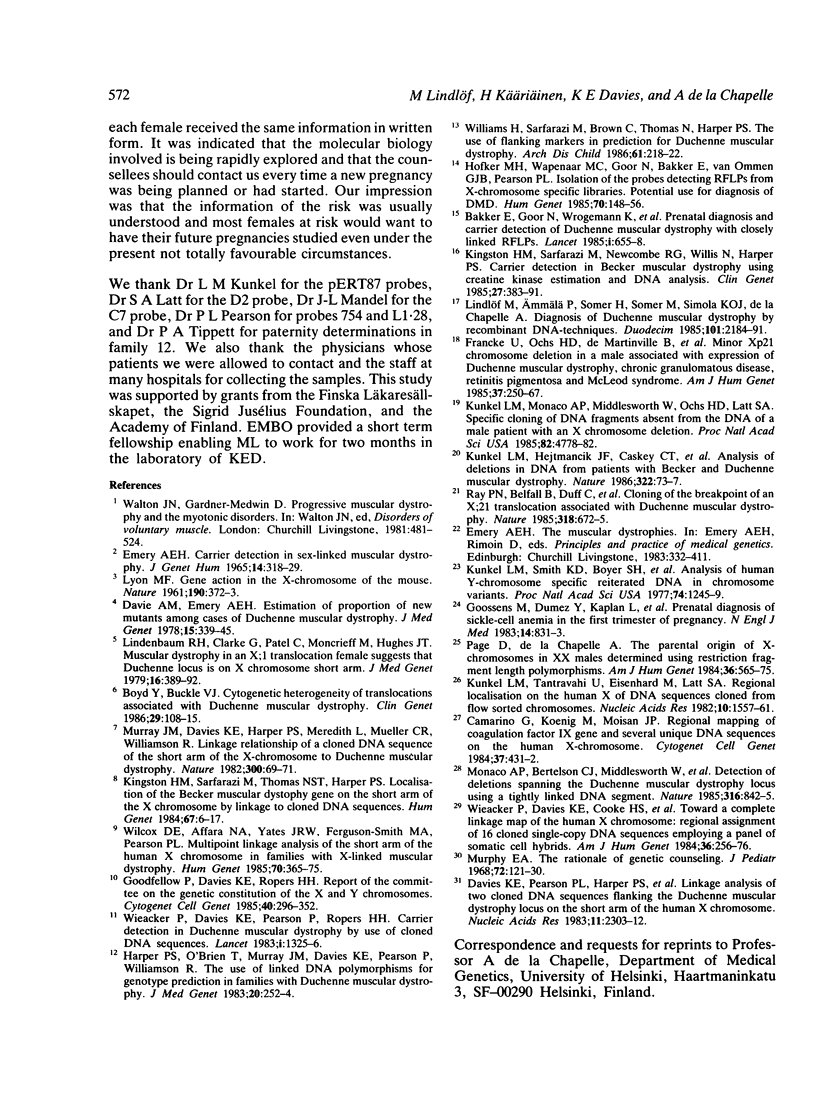
Images in this article
Selected References
These references are in PubMed. This may not be the complete list of references from this article.
- Bakker E., Hofker M. H., Goor N., Mandel J. L., Wrogemann K., Davies K. E., Kunkel L. M., Willard H. F., Fenton W. A., Sandkuyl L. Prenatal diagnosis and carrier detection of Duchenne muscular dystrophy with closely linked RFLPs. Lancet. 1985 Mar 23;1(8430):655–658. doi: 10.1016/s0140-6736(85)91325-x. [DOI] [PubMed] [Google Scholar]
- Boyd Y., Buckle V. J. Cytogenetic heterogeneity of translocations associated with Duchenne muscular dystrophy. Clin Genet. 1986 Feb;29(2):108–115. doi: 10.1111/j.1399-0004.1986.tb01232.x. [DOI] [PubMed] [Google Scholar]
- Davie A. M., Emery A. E. Estimation of proportion of new mutants among cases of Duchenne muscular dystrophy. J Med Genet. 1978 Oct;15(5):339–345. doi: 10.1136/jmg.15.5.339. [DOI] [PMC free article] [PubMed] [Google Scholar]
- Davies K. E., Pearson P. L., Harper P. S., Murray J. M., O'Brien T., Sarfarazi M., Williamson R. Linkage analysis of two cloned DNA sequences flanking the Duchenne muscular dystrophy locus on the short arm of the human X chromosome. Nucleic Acids Res. 1983 Apr 25;11(8):2303–2312. doi: 10.1093/nar/11.8.2303. [DOI] [PMC free article] [PubMed] [Google Scholar]
- Emery A. E. Carrier detection in sex-linked muscular dystrophy. J Genet Hum. 1965 Dec;14(4):318–329. [PubMed] [Google Scholar]
- Francke U., Ochs H. D., de Martinville B., Giacalone J., Lindgren V., Distèche C., Pagon R. A., Hofker M. H., van Ommen G. J., Pearson P. L. Minor Xp21 chromosome deletion in a male associated with expression of Duchenne muscular dystrophy, chronic granulomatous disease, retinitis pigmentosa, and McLeod syndrome. Am J Hum Genet. 1985 Mar;37(2):250–267. [PMC free article] [PubMed] [Google Scholar]
- Goodfellow P. N., Davies K. E., Ropers H. H. Report of the Committee on the Genetic Constitution of the X and Y Chromosomes. Cytogenet Cell Genet. 1985;40(1-4):296–352. doi: 10.1159/000132178. [DOI] [PubMed] [Google Scholar]
- Goossens M., Dumez Y., Kaplan L., Lupker M., Chabret C., Henrion R., Rosa J. Prenatal diagnosis of sickle-cell anemia in the first trimester of pregnancy. N Engl J Med. 1983 Oct 6;309(14):831–833. doi: 10.1056/NEJM198310063091405. [DOI] [PubMed] [Google Scholar]
- Harper P. S., O'Brien T., Murray J. M., Davies K. E., Pearson P., Williamson R. The use of linked DNA polymorphisms for genotype prediction in families with Duchenne muscular dystrophy. J Med Genet. 1983 Aug;20(4):252–254. doi: 10.1136/jmg.20.4.252. [DOI] [PMC free article] [PubMed] [Google Scholar]
- Hofker M. H., Wapenaar M. C., Goor N., Bakker E., van Ommen G. J., Pearson P. L. Isolation of probes detecting restriction fragment length polymorphisms from X chromosome-specific libraries: potential use for diagnosis of Duchenne muscular dystrophy. Hum Genet. 1985;70(2):148–156. doi: 10.1007/BF00273073. [DOI] [PubMed] [Google Scholar]
- Kingston H. M., Sarfarazi M., Newcombe R. G., Willis N., Harper P. S. Carrier detection in Becker muscular dystrophy using creatine kinase estimation and DNA analysis. Clin Genet. 1985 Apr;27(4):383–391. doi: 10.1111/j.1399-0004.1985.tb02280.x. [DOI] [PubMed] [Google Scholar]
- Kingston H. M., Sarfarazi M., Thomas N. S., Harper P. S. Localisation of the Becker muscular dystrophy gene on the short arm of the X chromosome by linkage to cloned DNA sequences. Hum Genet. 1984;67(1):6–17. doi: 10.1007/BF00270551. [DOI] [PubMed] [Google Scholar]
- Kunkel L. M., Hejtmancik J. F., Caskey C. T., Speer A., Monaco A. P., Middlesworth W., Colletti C. A., Bertelson C., Müller U., Bresnan M. Analysis of deletions in DNA from patients with Becker and Duchenne muscular dystrophy. Nature. 1986 Jul 3;322(6074):73–77. doi: 10.1038/322073a0. [DOI] [PubMed] [Google Scholar]
- Kunkel L. M., Monaco A. P., Middlesworth W., Ochs H. D., Latt S. A. Specific cloning of DNA fragments absent from the DNA of a male patient with an X chromosome deletion. Proc Natl Acad Sci U S A. 1985 Jul;82(14):4778–4782. doi: 10.1073/pnas.82.14.4778. [DOI] [PMC free article] [PubMed] [Google Scholar]
- Kunkel L. M., Smith K. D., Boyer S. H., Borgaonkar D. S., Wachtel S. S., Miller O. J., Breg W. R., Jones H. W., Jr, Rary J. M. Analysis of human Y-chromosome-specific reiterated DNA in chromosome variants. Proc Natl Acad Sci U S A. 1977 Mar;74(3):1245–1249. doi: 10.1073/pnas.74.3.1245. [DOI] [PMC free article] [PubMed] [Google Scholar]
- Kunkel L. M., Tantravahi U., Eisenhard M., Latt S. A. Regional localization on the human X of DNA segments cloned from flow sorted chromosomes. Nucleic Acids Res. 1982 Mar 11;10(5):1557–1578. doi: 10.1093/nar/10.5.1557. [DOI] [PMC free article] [PubMed] [Google Scholar]
- LYON M. F. Gene action in the X-chromosome of the mouse (Mus musculus L.). Nature. 1961 Apr 22;190:372–373. doi: 10.1038/190372a0. [DOI] [PubMed] [Google Scholar]
- Lindenbaum R. H., Clarke G., Patel C., Moncrieff M., Hughes J. T. Muscular dystrophy in an X; 1 translocation female suggests that Duchenne locus is on X chromosome short arm. J Med Genet. 1979 Oct;16(5):389–392. doi: 10.1136/jmg.16.5.389. [DOI] [PMC free article] [PubMed] [Google Scholar]
- Lindlöf M., Ammälä P., Somer H., Somer M., Simola K. O., de la Chapelle A. Duchennen lihasdystrofian diagnostiikka yhdistelmä-DNA-menetelmin. Duodecim. 1985;101(22):2184–2191. [PubMed] [Google Scholar]
- Monaco A. P., Bertelson C. J., Middlesworth W., Colletti C. A., Aldridge J., Fischbeck K. H., Bartlett R., Pericak-Vance M. A., Roses A. D., Kunkel L. M. Detection of deletions spanning the Duchenne muscular dystrophy locus using a tightly linked DNA segment. 1985 Aug 29-Sep 4Nature. 316(6031):842–845. doi: 10.1038/316842a0. [DOI] [PubMed] [Google Scholar]
- Murphy E. A. The rationale of genetic counseling. J Pediatr. 1968 Jan;72(1):121–130. doi: 10.1016/s0022-3476(68)80415-9. [DOI] [PubMed] [Google Scholar]
- Murray J. M., Davies K. E., Harper P. S., Meredith L., Mueller C. R., Williamson R. Linkage relationship of a cloned DNA sequence on the short arm of the X chromosome to Duchenne muscular dystrophy. Nature. 1982 Nov 4;300(5887):69–71. doi: 10.1038/300069a0. [DOI] [PubMed] [Google Scholar]
- Page D. C., de la Chapelle A. The parental origin of X chromosomes in XX males determined using restriction fragment length polymorphisms. Am J Hum Genet. 1984 May;36(3):565–575. [PMC free article] [PubMed] [Google Scholar]
- Ray P. N., Belfall B., Duff C., Logan C., Kean V., Thompson M. W., Sylvester J. E., Gorski J. L., Schmickel R. D., Worton R. G. Cloning of the breakpoint of an X;21 translocation associated with Duchenne muscular dystrophy. Nature. 1985 Dec 19;318(6047):672–675. doi: 10.1038/318672a0. [DOI] [PubMed] [Google Scholar]
- Wieacker P., Davies K., Pearson P., Ropers H. H. Carrier detection in Duchenne muscular dystrophy by use of cloned DNA sequences. Lancet. 1983 Jun 11;1(8337):1325–1326. doi: 10.1016/s0140-6736(83)92429-7. [DOI] [PubMed] [Google Scholar]
- Wilcox D. E., Affara N. A., Yates J. R., Ferguson-Smith M. A., Pearson P. L. Multipoint linkage analysis of the short arm of the human X chromosome in families with X-linked muscular dystrophy. Hum Genet. 1985;70(4):365–375. doi: 10.1007/BF00295379. [DOI] [PubMed] [Google Scholar]
- Williams H., Sarfarazi M., Brown C., Thomas N., Harper P. S. The use of flanking markers in prediction for Duchenne muscular dystrophy. Arch Dis Child. 1986 Mar;61(3):218–222. doi: 10.1136/adc.61.3.218. [DOI] [PMC free article] [PubMed] [Google Scholar]



